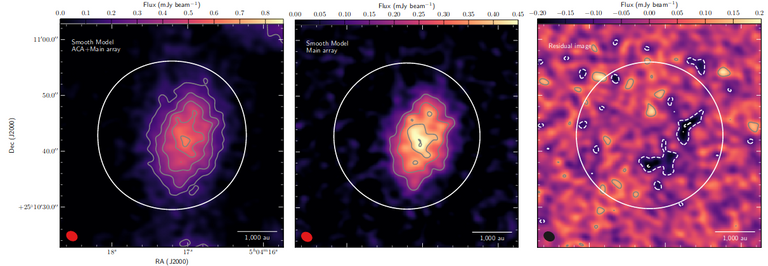Under the influence of gravity, stars are born from collapsing clouds of gas and dust. These dense regions form a pre-stellar (i.e., before star) core. Although much is known about this process, it is difficult for astronomers to peer through the dust to see exactly what is going on with these cores inside the dusty clouds. Within the core, there could be multiple structures (i.e., kernels) which could form resulting in a binary star system. Also, the core could fragment into several kernels leading to a similar result. In a recent submission to the Astrophysical Journal, astronomers used the Atacama Large Millimeter Array (ALMA) to investigate the central region of a dense cloud core of a 8 solar mass pre-stellar object. One of the images they generated of the core is shown in Figure 1.

The density distributions from the observational data were then used to generate a corresponding model of the region. This model was then used to create a simulated image of the region (see Figure 2, left and center panels). Then this simulated image was subtracted from the equivalent 'real' image to reveal any possible kernels within the cloud (see Figure 2, right panel).

The results show there are possibly multiple kernel fragments with in this core. This fragmentation is in line with theories of star formation that include observational evidence from multiple star systems with objects that are "born" together. More details about the details of fragmentation are necessary for astronomers to piece together the entire story of stellar evolution.
References
Caselli, P. et al. 2019, https://arxiv.org/pdf/1902.05299.pdf
This post has been voted on by the SteemSTEM curation team and voting trail in collaboration with @curie.
If you appreciate the work we are doing then consider voting both projects for witness by selecting stem.witness and curie!
For additional information please join us on the SteemSTEM discord and to get to know the rest of the community!
Don't forget to join steemSTEM Discord channel.
https://discord.gg/vBXT9K
You can find the guidelines for STEM posts, and people sharing your passion: @terrylovejoy @svemirac @rifkan @astromaniac @tellurian @miroslavrc ... At least 10 astro-photographers / enthusiasts / PhD students / scientists
See you there!